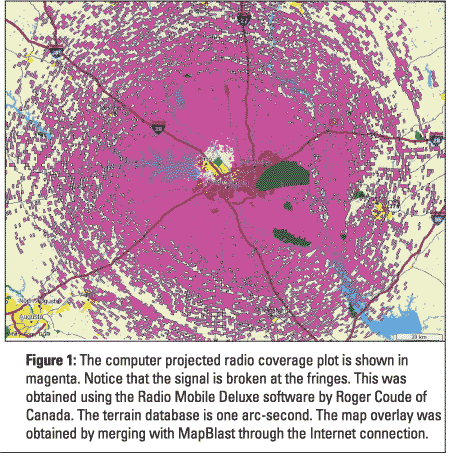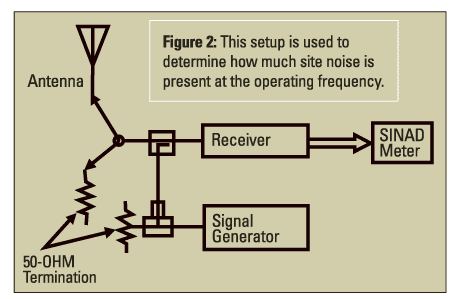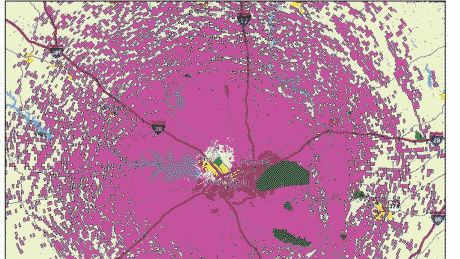Base station planning isn’t simple
Planning and implementing a base station is an involved process requiring knowledge of the desired coverage area. The location must provide coverage of the desired area utilizing the available ERP (effective radiated power).
The limiting factor in the range of a base station is more likely the receiving range rather than the transmitting range. Generally, it is of no value for the transmitter to outdistance the receiver. The receiving range is determined largely by site noise and interference factors. No matter how good the bench sensitivity, the local site noise will determine the effective sensitivity.
Typically, a base station is located at a shared site, which can mean sharing the same building, tower and even antenna. Or, it can simply mean sharing the same general location. Often sites are shared because no other nearby site provides the ground elevation needed to achieve the desired radio coverage. For example, a mountaintop location near a major metropolitan area is cluttered with antennas. You will find the same situation with tall buildings in major cities.
Co-locating base stations using the same building and tower offers considerable advantages. Costs are reduced by the use of a single tower. By using transmitter combiners, multicouplers and duplexers, a single broadband antenna can be shared among several users.
In addition, sharing a single building with a common grounding system also can save money. Many of the expenses associated with the common elements of the site also can be shared among the users.
However, exclusive sites have their own advantages, as well as some disadvantages. First, it is easier to keep the site “RF clean” if you are the exclusive user. The downside is that you are required to carry the entire burden of tower and antenna maintenance, necessary road and shelter maintenance, as well as grounding system installation. The requirements of these burdens can be small or great, depending on the particular site.
When a site is under consideration for the location of a base station, a radio coverage plot typically is run with a computer program in order to establish whether the site can provide the desired radio coverage. Several different computer models are available. The computer runs coverage plots using the associated terrain elevation database to make computations of signal level, in order to establish a contour.
Common sense must prevail when using such computer models to estimate radio coverage. If you’re going to make an error, it is best to err on the conservative side. Figure 1 shows the results obtained by using the Radio Mobile Deluxe1 software to estimate radio coverage. This plot was developed using a one arc-second terrain elevation database to provide excellent resolution.

Once the site has been chosen and shown to provide the necessary radio coverage, an on-site noise and interference study should be done. A receiver at the base station operating frequency is taken to the site and set up to perform the effective sensitivity test.
The test is run as follows (see Figure 2). First, with the 50-ohm termination connected to the input of the signal sampler, the signal generator is set to the receiver frequency and the amplitude adjusted to produce 12 decibels (dB) on the SINAD meter. Then, note the output level of the signal generator and record it as reference level 1.

Next, the 50-ohm termination is removed from the signal sampler and the antenna is connected. The SINAD reading should be degraded by the site noise picked up by the antenna. The output level of the signal generator then is increased to return the SINAD meter reading to 12 dB. The output level of the signal generator is noted and recorded as reference level 2.
The amount of degradation caused by the site noise is the difference in decibels between reference level 2 and reference level 1 — the smaller the difference, the lower the site noise. If you find high site noise at the operating frequency you might want to reconsider this site — it will only get worse.
If the site noise is relatively low, you should check for possible intermodulation and receiver desense from sources on the site or nearby. Intermodulation studies are run with computer programs that use known transmitter frequencies from other on-site transmitters. Third-order intermodulation products are generally the most troublesome, although higher-order products also can be a problem.
I saved the discussion of the base station radio for last, not because it is the least important element, but rather because I wanted to demonstrate the other factors are quite important also. In fact the radio is a very important element of an effective base station. When contemplating such devices, the question that must be answered at the beginning is, what constitutes a base station radio?
I remember taking a tour many years ago of what was purported to be an ultra-modern two-way radio dispatch center. While most of the group was impressed with all the bells and whistles of the dispatch console, I was more curious about the base station radios connected to the consoles and how they were connected.
During the question-and-answer period after the demonstration, I asked about the base station radios. The tour guide opened up a closet and I discovered that the base station radios were actually mobile radios on 12-volt power supplies. Remember this: a mobile radio on a power supply does not a base station make!
A base station radio should be designed to standards that are more rigid. For example, a base station should have greater selectivity than its mobile counterpart. Intermodulation rejection also should be better. Mobile radios are designed to be very wideband, especially in the front end. (Imagine using a mobile radio with a 24 MHz-wide front end at a congested radio communications site.) The more tuned stages ahead of the first active device in a receiver, the better the intermodulation rejection capability of the receiver.
Placing cavity filters ahead of the receiver improves the overall selectivity of the receiver and reduces broadband noise at the input. Placing them between the transmitter and the antenna reduces broadband noise and other spurious signals radiated by the transmitter.
Also, placing an isolator on the transmitter output improves the intermodulation rejection performance of the transmitter output circuit. Your RF neighbors will appreciate these considerations. Finally, do not place the isolator between the receiver leg and antenna — you won’t hear much if you do.
Modern base stations may use programmable PLL (phased-lock loop) synthesizers. In some cases, many frequencies may be factory programmed with dip switches used to select the specific frequency of operation for the particular base station. Other base stations may be completely programmable using a computer and the manufacturer’s software to set the station’s operating parameters.
One thing that a base station should include is metering. A base station might include built-in meters with switches to monitor various circuits or a metering plug might be used with a special test set in order to gauge the various circuits.
Some stations only provide a relative signal strength indicator (RSSI). This provides a relative DC indication of input signal level. A calibration chart can be made to indicate the signal input level to the receiver by using a calibrated signal generator to supply various input signal levels to the receiver.
Choose your base station carefully. Avoid the temptation to use a mobile radio on a power supply. Although you might get away with this in some remote locations, it usually will lead to trouble.
Maintain vigilance on your communication site(s). Frequent checks on the noise level and other interference problems at the site will help you to keep it RF clean.
Record the noise level measurements so you can tell when the noise has increased and what has been added to the site since the last good measurement was made. Let it go too long and you will lose that advantage.
Until next time — stay tuned!
1 Radio Mobile Deluxe is freeware from Roger Coude of Canada. It uses the Longley-Rice model.

















